How to make a dollhouse bellpull
ONLINE MINIATURE NEEDLEPOINT EMBROIDERY TUTORIALS

These tutorials were originally written to help people who had bought my dollhouse needlepoint kits – they show you how to do the stitching and assemble each type of kit. In November 2024 I retired, so these pages are now a ‘legacy archive’ only. I NO LONGER SELL THESE KITS, so please do not contact me asking where you can buy them! I plan to keep these tutorials available until at least the end of 2026, so that people who bought kits but haven’t made them up yet have a while to use the tutorials to complete their kits 🙂
These doll’s house scale bellpull designs make a lovely addition to room settings of all kinds. They are simple to stitch, and don’t take very long, either! The kits include an exclusive cast metal bellpull end, which help to make these projects look so realistic!
The miniature bellpulls are to be worked on 32 count silk gauze, so fine detail can be achieved without a very tiny count of silk gauze being used.
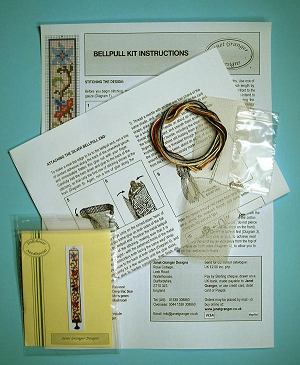
The miniature needlepoint bellpull kits contain a piece of 32 count silk gauze, a colour block chart to count the design from, a suitable needle, Anchor stranded cotton (use one strand), a polished metal bellpull end and full instructions.
This tutorial features the ‘Judith’ doll’s house bellpull design.
If you have never done miniature needlepoint before, start by reading the BASIC EQUIPMENT and NEEDLEPOINT STITCHES tutorials first, then come back to this page.
Before you begin stitching, you will need to make a card mount for the silk gauze. This will make it much easier to work on, and help to keep your stitch tension even. Cut a piece of stiff card 6½ x 2½ inches, with an aperture of 5 x 1 inches. Fix the silk gauze to the card with masking tape along all four edges, as tautly as possible. See the HOW TO MOUNT SILK GAUZE tutorial for details.
Identify the thread colours supplied in the kit using the colour key, then, using tent stitch and one strand of the Anchor stranded cotton, start the design in the centre, using tent stitch. Remember that one square on the chart equals one stitch, and always use a ‘stabbing’ motion, not a ‘sewing’ (scooping) one.
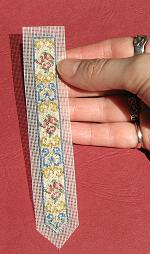
When the stitching is complete, if it has become slightly mis-shapen (especially if you did not use a card mount to hold the silk gauze taut), press it on the reverse side with a medium hot iron with steam, over a padded ironing board, pulling the fabric gently if necessary to get it dead square.
Trim the finished stitching so that there is a margin of a quarter of an inch of unworked gauze all round. It is NOT necessary or desirable to use a fabric glue around the edges first.
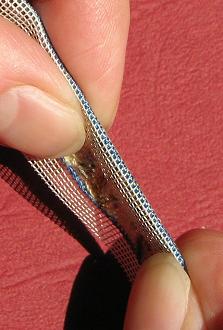
Holding the stitching with the right side facing away from you, fold the unworked gauze to the back of the work (that is, towards you), making sure that no unworked gauze will be visible from the front. Crease the edge with your nail as you go.
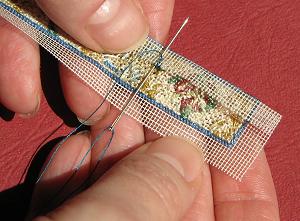
Thread a sharp sewing needle (not supplied) with sewing cotton in a neutral shade – please note that for this tutorial, I have used a strong colour so that the stitches show up better in the photos. Starting about an inch from the top along one of the long sides, start to stitch down the unworked gauze to the back of the needlepoint stitches already worked, taking care that the needle does not go through to the front, otherwise your oversewing stitches will show on the front of the finished bellpull.
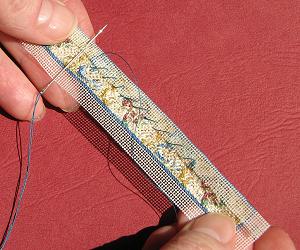
Make the stitches about a quarter of an inch apart, and three or four holes in from the cut edge (otherwise the gauze may ‘shred’). As you can see from the photo, the stitches are quite loose – this is so that the bellpull does not become distorted by the tension of the stitches.
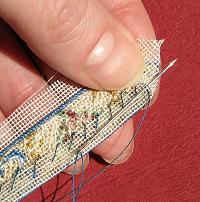
When you reach the bottom edge of the bellpull, turn in the adjacent edge of gauze as you approach a corner, and hold it in place with your thumb. Make a couple of tiny stitches at the place where the two seam allowances overlap, only stitching through the unworked gauze.
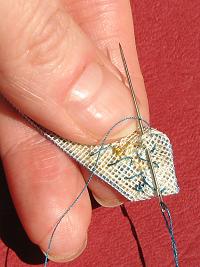
Continue oversewing until you reach the next corner (at the pointed tip of the bellpull, this will be only one or two stitches later), then repeat the sequence of folding in and holding down the new side, stitching the seam allowances together, then oversewing the new side in place.
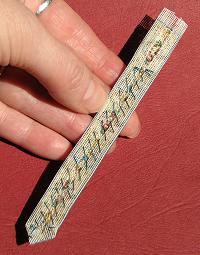
Continue oversewing up the second long side, and secure the end of thread an inch from the top edge.

To attach the polished metal bellpull end, first fold down the seam allowance of the top edge of the stitching, making sure once again that no unworked gauze shows from the front. Crease the edge in place with your nail.
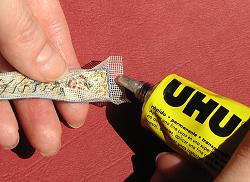
Unfold this gauze seam allowance, and apply a contact adhesive such as UHU sparingly and carefully to the underside of the unworked gauze ONLY, all the way along the top edge.
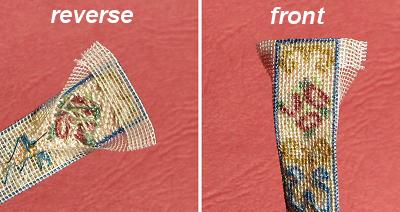
Making sure that you do not inadvertently get glue on the front of the stitching, fold the seam allowance back down, sticking the unworked gauze to the reverse of the needlepoint stitching, all the way along the top edge. (Please note : the extreme edges will be unworked gauze stuck onto unworked gauze.)

To do the next part, it may help to have a friend to help, as you need to be doing two things at once! First, spread glue thinly onto the fixing plate (lower part) of the polished metal bellpull end, on both sides.
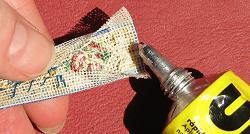
Ask the friend to hold the bellpull end by the top (decorative) part, while you spread glue on the turned down gauze seam allowance.
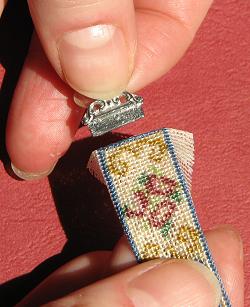
Holding the stitched bellpull with the right side towards you, place the metal bellpull end in position behind the top edge of the stitching, making sure that the decorative side is facing the front
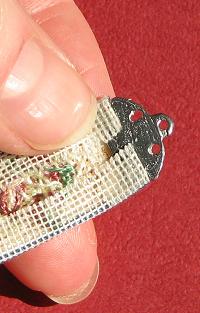
Turn the stitched bellpull over, and carefully wrap the top edge of the stitching seam allowances around the metal bellpull end, and press into place. Make sure that you do not get glue on the front of the bellpull while you do this.
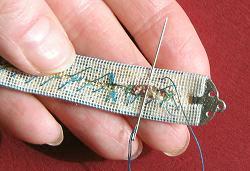
When the glue is completely dry, using the sharp needle and sewing cotton as before, finish oversewing the unworked gauze of the long side edges down, for the top inch along each side.
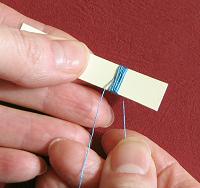
To make the tassel that hangs from the bottom edge of the bellpull, select two strands of thread in one colour, from the threads left over from the main needlepoint stitching. Refer to the photo on the front of each kit pack for guidance on which shade was used for that particular design. Thread a sharp needle with one of the strands of thread, and put it to one side for now. Cut a piece of thin card three eighths of an inch wide by about two inches long. Take the second strand of thread, and wind it around the card – about twelve turns will use up the one foot length. Leave the two ends hanging down below the card.

Take the threaded needle, and slide it under the bundle of twelve threads, making sure that the needle does not pierce any of the threads.
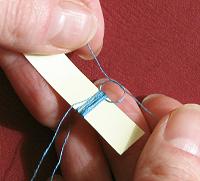
Leaving the needle threaded, tie the thread into a knot at the top edge of the card, gathering the threads up. Leave the thread end nearest the needle with at least six inches of thread available to use later.
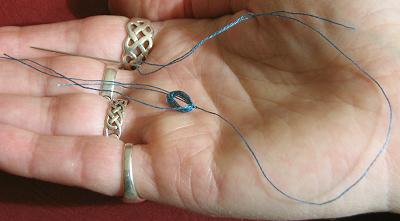
Slide the bundle of thread off the card, and smooth down the three loose ends with the loop of twelve threads.
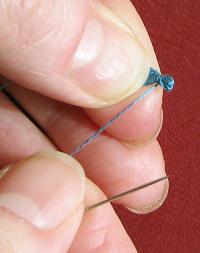
Holding the bundle securely in one hand, about an eighth of an inch from the knot at the top, wrap the thread with the needle still attached around the bundle twice, as close to your thumbnail as you can get. Hold these two wraps in place with your index finger.
Poke the needle through the bundle, once below…
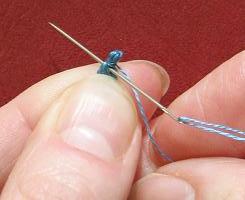
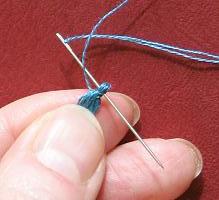
…and then once above the wraps to secure.
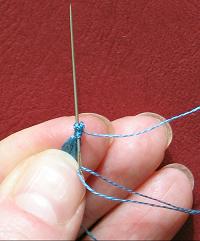
Then, poke the needle up through the wraps and out the top of the bundle, as near to the knot as you can.

Positioning the needle exactly in the centre of the bottom edge of the bellpull, make a few running stitches through the reverse side (unworked gauze) for about half an inch. Pull the thread through until the tassel sits comfortably but not too tightly at the base of the bellpull, then finish off the length of thread securely with a few back stitches.
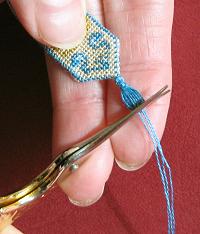
With a sharp pair of scissors, trim the bottom edge of the bundle of threads, to make the tassel. Slightly curving the line from side to side makes a more realistic tassel than cutting the threads straight across.
Your bellpull is now complete, and ready to display in your dolls’ house! It can be fixed to the wall using GripWax or BluTack, or if you have tiny pins, the bellpull end has a hole pre-drilled at the top, to hang it from.
